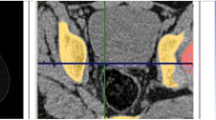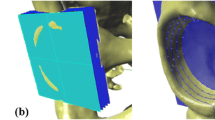Abstract
Background
Various attempts have been made to assess the inclination angle of the acetabulum utilizing new imageprocessing technologies to enable three-dimensional reconstruction of the acetabulum. However, reliability of these methods has not been estimated in comparison with anatomical measurements. This study developed a geometric method for measuring the acetabular inclination with radiograms and evaluated the reliability of this method by comparing the anatomically measured acetabular inclination angle of the same dry pelvic bone.
Methods
One hundred and ten acetabulums from 55 human pelvis specimens were used. The uppermost, most frontal, and posterior lowermost points of the acetabular rim were determined, and an axis perpendicular to the triangular plane formed by these three points was defined as the anatomical inclination axis of the acetabulum. The anatomical lateral and anterior opening angles were directly measured using a tool we devised for this purpose. Posteroanterior and lateral radiograms of each pelvis were taken concurrently and three points were marked by small metal plates. Based on projections of these three points onto the posteroanterior and lateral images, we geometrically measured and calculated the lateral and anterior opening angles of the acetabulum.
Results
Anatomical measurements of the lateral opening angles ranged from 38° to 63° (mean 51.0°), and anterior opening angles from 10° to 36° (mean 20.8°). Geometric measurements of the lateral opening angles ranged from 40° to 61° (mean 50.5°), and anterior opening angles ranged from 7° to 35° (mean 20.8°). Geometrically measured acetabular inclination angles were highly correlated with the anatomically measured ones for both the lateral and anterior opening angles, with correlation coefficients of 0.803 and 0.822, respectively.
Conclusions
Our geometric measurement method of the acetabular inclination angle enabled us to calculate the lateral and anterior opening angles, which were very close to the corresponding anatomical measurements. This method allows three-dimensional evaluation of the anatomical structure of the hip and may be useful in predicting progression of coxarthrosis by measuring the femoral neck shaft and anteversion angles.
Similar content being viewed by others
References
Sharp IK. Acetabular dysplasia: the acetabular angle. J Bone Joint Surg Br 1961;43:268–272.
Laforgia R, Specchiulli F, Solarino G, Nitti L. Radiographic variables in normal and osteoarthritic hips. Bull Hosp Joint Dis 1996;54:215–221.
Delaunay S, Dussault RG, Kaplan PA, Alford BA. Radiographic measurements of dysplastic adult hips. Skeletal Radiol 1997;26:75–81.
Li PL, Ganz R. Morphologic features of congenital acetabular dysplasia: one in six is retroverted. Clin Orthop 2003;416:245–53.
Reikerås O, Bjerkreim I, Kolbenstvedt A. Anteversion of the acetabulum and femoral neck in normals and in patients with osteoarthritis of the hip. Acta Orthop Scand 1983;54:18–23.
Buckley SL, Sponseller PD, Magid D. The acetabulum in congenital and neuromuscular hip instability. J Pediat Orthop 1991;11:498–501.
Anda S, Terjesen T, Kvistad KA, Svenningsen S. Acetabular angles and femoral anteversion in dysplastic hips in adults: CT investigation. J Comput Assist Tomogr 1991;15:115–120.
Anda S, Terjesen T, Kvistad KA. Computed tomography measurements of the acetabulum in adult dysplastic hips: which level is appropriate? Skeletal Radiol 1991;20:267–271.
Jacquemier M, Jouve JL, Bollini G, Panuel M, Migliani R. Acetabular anteversion in children. J Pediat Orthop 1992;12:373–375.
Anda S, Svenningsen S, Grøntvedt T, Benum P. Pelvic inclination and spatial orientation of the acetabulum: a radiographic, computed tomographic and clinical investigation. Acta Radiol 1990; 31:389–394.
Wientroub S, Boyde A, Chrispin AR, Lloyd-Roberts GC. The use of stereophotogrammetry to measure acetabular and femoral anteversion. J Bone Joint Surg Br 1981;63:209–213.
Fairbank JCT, Howell P, Nockler I, Lloyd-Roberts GC. Relationship of pain to the radiological anatomy of the hip joint in adults treated for congenital dislocation of the hip as infants: a long-term follow-up of patients treated by three methods. J Pediat Orthop 1986;6:539–547.
Shiino K. Über die Hüftpfanne. Zeitschrift für Morphol und Anthropol 1914/1915;17:325–356.
Murphy SB, Kijewski PK, Millis MB, Harless A. Acetabular dysplasia in the adolescent and young adult. Clin Orthop 1990; 261:214–223.
Jacobsen S, Sonne-Holm S, Lund B, Søballe K, Kiær T, Rovsing H, et al. Pelvic orientation and assessment of hip dysplasia in adults. Acta Orthop Scand 2004;75:721–729.
Tönnis D, Heinecke A. Acetabular and femoral anteversion: relationship with osteoarthritis of the hip. J Bone Joint Surg Am 1999;81:1747–1770.
Kim SS, Frick SL, Wenger DR. Anteversion of the acetabulum in developmental dysplasia of the hip: analysis with computed tomography. J Pediat Orthop 1999;19:438–442.
Mast JW, Brunner RL, Zebrack J. Recognizing acetabular version in the radiographic presentation of hip dysplasia. Clin Orthop 2004;418:48–53.
Author information
Authors and Affiliations
About this article
Cite this article
Nagao, Y., Aoki, H., Ishii, SJ. et al. Radiographic method to measure the inclination angle of the acetabulum. J Orthop Sci 13, 62–71 (2008). https://doi.org/10.1007/s00776-007-1188-0
Received:
Accepted:
Published:
Issue Date:
DOI: https://doi.org/10.1007/s00776-007-1188-0




